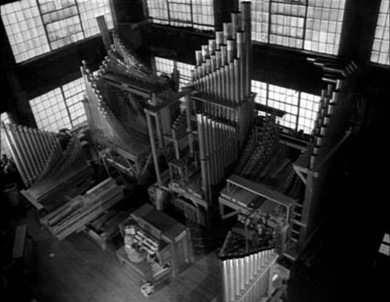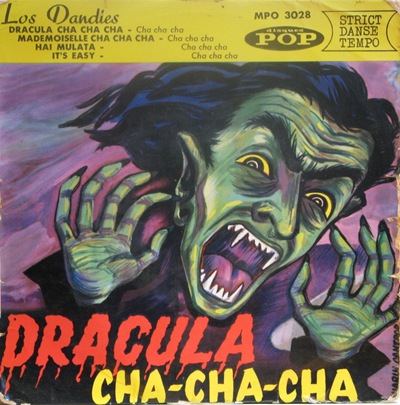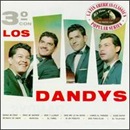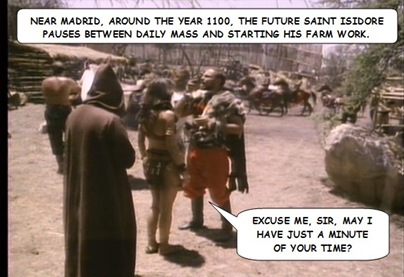
THE TAGLINE:
"A new wave picture you cannot forget! A sensation about a new dimension!"
THE PLOT:
Emerging from a river following a terrible car accident which claimed the lives of all of her friends, Mary Henry decides to hurriedly leave town and accept a job as a church organist in Salt Lake City. Just short of her destination, Mary first begins to see visions of a ghoulish man leering at her through the car window, and then spots an abandoned pavilion off in the distance to which she feels oddly drawn. Continuing on to her new home, Mary does her best to settle into her new life, but can't escape the cold feelings of isolation and detachment which have eaten away at her since the accident. Her efforts to return to normalcy aren't made any easier due to the lecherous advances of her neighbor John and the continued visions of The Man and his fellow zombie-like companions from the old carnival. The situation comes to a head when Mary begins having episodes in which she can no longer be seen or heard by the residents of the city. Feeling the answers can only be found in the remains of the old carnival, Mary drives out to the place by herself. There, she witnesses a bizarre dance of the dead to which she is at first drawn to participate in, but then flees from as the ghouls try to chase her down. Meanwhile, back at Mary's old home town, a startling discovery is made.
THE POINT:
I do spoilers here, it's no big deal. I mean, really, how many people are gonna get upset when the stunning conclusion to Santa Claus Conquers The Martians is revealed before they watch it? This movie is different though. Not because the review will spoil the ending; the "shock" at the end of Carnival of Souls has been so overdone in film that it has very little impact these days. And not because it will spoil any sudden turns somewhere else in the story; if anything, the narrative is almost too straightforward. And certainly not because it will spoil any big jaw dropping effects-laden money shots; this movie has none. (The effects budget consisted of the cost of a mirror, some clown white makeup, and $38 to the city of Lecompton, KS for repairs to a bridge.) No, the reason to avoid reading this review is due to the expectations it might raise. You see, like so many reviewers before me, I'm going to write a veritable love poem to this film, one so gushing that it will leave Elizabeth Barrett Browning spinning in her grave. And what's going to happen is that you'll rush out and pick up the pristine 2-disc Criterion DVD set, hurriedly pop it in the player expecting the Citizen Kane of horror movies, and 84 minutes later you'll be staring at the words 'The End' and thinking to yourself, "Oh, c'mon! That's it?"
And that's going to happen because that's not how you're supposed to see Carnival of Souls for the first time. Here's what you need to do. Go to Wal-Mart or Dollar General and grab a cheap blurry pressing of the movie for a few bucks. Better yet, splurge on one of those Mill Creek 50 movies for 20 bucks box sets; their print really stinks. Then go home and lay it down somewhere and forget about it. A month or two from now when this post has completely passed from your memory, when it's late and you're too tired to do anything but watch TV but there's absolutely nothing on, remember that you bought Carnival of Souls and throw it on. And that's when it's going to get you, when you're least expecting it. I know it sounds nuts, but this is just one of those movies you shouldn't seek out. Just let it find you on its own. So, now you've been warned. If you've never seen Carnival of Souls, but think you might, then... get lost.
Still here? Fine. Then let's go ahead and let the love flow like a mountain stream. Ah, Carnival of Souls, how DO I love thee? Let me count the ways. I love thee to the depth and breadth and height your meager $30,000 budget managed to reach. Yes, thanks to the lack of funds and the 2 week shooting schedule, there's still more than enough gaffs, bad sound looping, and rushed one-takes in Carnival of Souls to equal any other two B-Movies combined. But thanks to the two decades of experience filming educational and industrial shorts, director Herk Harvey and his six man crew managed to rise above the constraints of the production to create more than a few moments of quiet, eerie beauty.This is especially true in those scenes where the film needs it most, those which accentuate Mary's isolation from the rest of humanity. There's the battered Mary emerging from the river onto a dagger shaped sandbar alone and still so far from the shore. There's Mary transfixed before her organ playing an unearthly melody, her only audience the stained glass saints and martyrs in the windows above her. There's Mary walking through the deserted Saltair pavilion with the Salt Lake City skyline, and therefore the nearest living souls, far away on the horizon. (Incredibly, Saltair was a real abandoned carnival originally built by the Mormons in 1893. Herk was creep out when he saw it from a distance while driving along the highway, a scene he recreates for Mary early in the movie.) So despite the fact that a good chunk of the film visually resembles one of Herk's classroom films, there are still a number of scenes in Carnival of Souls which will embed themselves into your psyche for a long time to come.
I also love thee, Carnival of Souls, with a passion put to use In my old griefs, and with my childhood's faith that monsters existed. Which is to say, in this context, that this movie somehow creeps me out in much the same way old B-movies did when I was a little kid. The difference being that, while movies like The Brain That Wouldn't Die and Attack Of The Crab Monsters now appear quaint to my adult sensibilities, Carnival Of Souls works on adults. (In truth, I didn't even see it until I was pushing 30.) Along with the aforementioned scenes, a good deal of the credit for this has to go to the music. Consisting almost entirely of organ pieces, the film's soundtrack relentlessly maintains a thick atmosphere of dreamlike other-worldliness in which you find yourself caught up in. Lacking the jump scares or nail-biting tension of the typical horror movie, Carnival of Souls succeeds almost entirely by sucking you into the realness of its unreality. (Sorry for all the tin-ear lyricism going on in this review, but I did warn you it would be a love poem.)
And, Carnival of Souls, if God choose, I shall but love thee better after I discover the main character's been dead (or nearly so) for the whole movie. Of course, as noted earlier, this twist ending is hardly original. The device goes all the way back to Ambrose Bierce's 1891 story, An Occurrence At Owl Creek Bridge, and has been recycled every other year since, sometimes quite effectively (Jacob's Ladder, The Others) and sometimes... er, not so much (Soultaker). The reason the premise works so well in Carnival of Souls, though, is the ambiguity of the situation. Like any good dream, the ending is open to interpretation. One explanation, similar to that found in The Others, has Mary as an unwitting ghost whom the spirits of Saltair have come to take home. Another possibility is that the whole movie, ala Bierce, is simply what occurs in Mary's mind in the seconds before she dies. Then there's the Jacob's Ladder scenario in which the events of the movie represent some form of Purgatorial state through which Mary must pass before moving on into the afterlife. It's a feasible conclusion considering the interchange with the physician to whom Mary has decided to confide in about the apparition of The Man. "I'm not a psychiatrist, and perhaps I'm being clumsy at all this" the doctor says, "but I am suggesting that perhaps this figure represents a guilt feeling." (I also found one reviewer who claimed the whole movie was some sort of feminist manifesto on the suppression of women in the 1950s. I guess anything's possible, but it's hard to imagine the guy who directed films like Why Study Home Economics, Manners In School, and Pork: The Meal With A Squeal was really that much into radical feminism.)
From a Catholic viewpoint, of course, the Purgatory angle is the most interesting, mainly because filmmakers so rarely get the concept right. It's not all their fault. Purgatory has become one of those teachings lots of people, even some Catholics, just don't understand anymore. The most common misconception appears to be the belief that Purgatory represents some kind of second chance for the condemned soul. it's a nice idea, but one that is expressly denied in the Catechism. "Death puts an end to human life as the time open to either accepting or rejecting the divine grace manifested in Christ... Each man receives his eternal retribution in his immortal soul at the very moment of his death." Maybe it's just me, but I don't see a lot of breathing room for second chances in that statement. The basic teaching about Purgatory is simply that "all who die in God's grace and friendship, but still imperfectly purified, are indeed assured of their eternal salvation; but after death they undergo purification, so as to achieve the holiness necessary to enter the joy of heaven. The Church gives the name Purgatory to this final purification of the elect, which is entirely different from the punishment of the damned." Almost all Christian sects accept this final purification of the soul as necessary, it's just that the typical Protestant understands the process to be instantaneous while the Catholic imagination (especially post-Dante) has always envisioned it as an experienced state-of-being. Oddly enough, given that we're talking about an experience not limited by the human body's fixed perception of Space/Time, I suppose it's theoretically possible that both sides could ultimately be right. (I'll let somebody smarter than me work out the quantum mechanics.) Whichever the case though, it has to be said, the Catholic version sure does make for better theater.
So, with all that in mind, if we accept the theory that the events in Carnival of Souls somehow represent Purgatory for the character of Mary, we have to reluctantly admit that Herk and his crew got things a little bit wrong as this Purgatory appears to be the theologically incorrect kind. (Which doesn't make me love you less, Carnival of Souls. I love thee freely, as men strive for right yet continuously screw up anyway.) What we have here basically is Mary being offered, after death, a second chance to correct the chief error of her life; her cold and emotionally detached attitude towards to the world and every person she has ever encountered in it. At every step, Mary is reminded of her spiritual aridity, starting with the man who actually built the organ she will play. "It takes more than intellect to make a musician" he tells her, "Put your soul into it." The pastor for whom she works chastises her for skipping out on her welcome reception. "We'll let it go at that for the time being. But, my dear, you cannot live in isolation... from the human race, you know." Even her house-mate John continuously derides Mary for her coldness. (Okay, it's true that John's a creepy perv who starts drinking the minute he wakes up and is just trying to get Mary in bed, but still, he recognizes her problem.) Sadly, Mary rejects every effort to ignite her feelings for her fellow man and she is ultimately claimed by the lost souls of Saltair as one of their own. Rejecting her second chance, Mary is, as the final shot reveals, truly dead.
Even if the Purgatory theology is a bit flawed in Carnival of Souls, the sin for which Mary suffers is actually quite real. The Catechism reminds us. that "there is a certain resemblance between the unity of the divine persons and the fraternity that men are to establish among themselves in truth and love. Love of neighbor is inseparable from love for God. The human person needs to live in society. Society is not for him an extraneous addition but a requirement of his nature. Through the exchange with others, mutual service and dialogue with his brethren, man develops his potential; he thus responds to his vocation." And what exactly is that vocation? "The vocation of humanity is to show forth the image of God and to be transformed into the image of the Father's only Son." Mary tried to live her life as a solo act and in so doing denied her soul it's ultimate goal. Heavy stuff for a flick thrown together by a bunch of guys on their two week vacation. But that's just one of the reason's I love this movie, love it with the breath, smiles, tears, of all my life! And you just might too, but only if you didn't read this review first.
THE STINGER
The poet Elizabeth Barrett Browning once spent a few years locked away from humanity following the death of her brother by drowning. Unlike Mary, however, Elizabeth found her way back into society, eventually marrying and writing her most popular works, including the much quoted Number 43 from Sonnets from the Portuguese which I have so cruelly abused in this review. Just saying sorry now, Elizabeth, so I don't have to pay for it later.


















